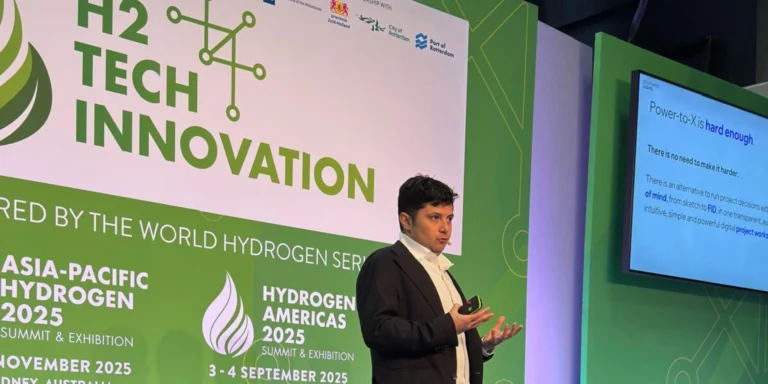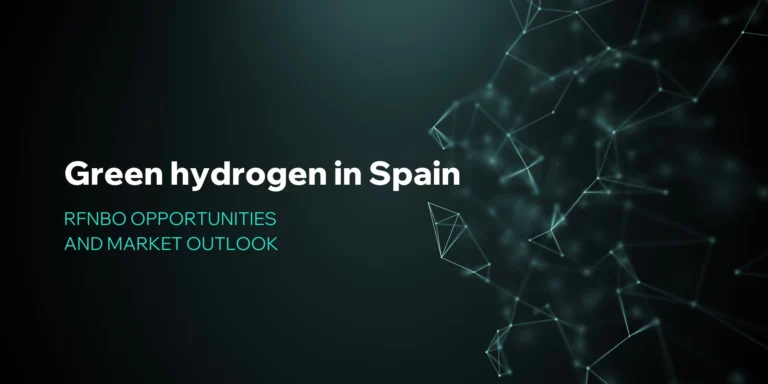Since the introduction of the European Green Deal in 2019, the European Union (EU) has implemented strong sustainability policies aimed at achieving climate neutrality by 2050. For this purpose, multiple work guidelines have been developed, including those for the energy sector.
Additionally, in 2022, in response to the energy crisis triggered by Russia’s invasion of Ukraine, the REPowerEU plan was implemented. Its main goals are to reduce dependence on fossil fuel supplies from Russia and to accelerate the energy transition to renewable sources. One of the action lines of this initiative is to promote the use of renewable hydrogen as an energy vector.
In this context of seeking decarbonization and energy independence, the European Commission’s Directorate-General for Energy developed the Delegated Acts. Their purpose is to define and regulate the energy that can be used for the production of Renewable Fuels of Non-Biological Origin (RFNBOs), and how to calculate the reduction of greenhouse gas emissions in the synthesis and use of these. It’s important to mention that RFNBOs primarily refer to renewable hydrogen and other fuels that can be produced from it, such as ammonia, methanol, or other e-fuels.
In this report, we present a summary of the main considerations regarding the first Delegated Act, which should be kept in mind for the development of a renewable hydrogen project, along with some general guidelines considering the energy industry in Europe.
What are the Delegated Acts?
The Delegated Acts consider three main requirements: Additionality, Temporal Correlation and Geographical Correlation. Strictly speaking, “general rules” are indicated, which simplify the previous restrictions. However, these are only applicable in Off-Grid operation cases and in possible future scenarios when the energy supply has a lower carbon footprint. Let’s review everything in more detail below.
Additionality
Specified in Article 5 of the first Delegated Act, its objective is that renewable electric energy generated for RFNBOs does not prey upon or compete with electricity generated for other applications. In particular, it considers that the total renewable energy production of the generator(s) must be equal to or greater than the energy consumption of the renewable fuel production.
Any fuel (hydrogen) production that is not covered by the total energy supply of renewable generators will not be considered renewable. The fuel production can be located in the same facility at the renewable energy system, or connected to the generators via the grid and provided through a PPA.
Additionally, it is required that the start-up of the renewable energy system cannot be earlier than 36 months from the start-up of the electrolyzer plant. Furthermore, it is required that the generation system had not received any investment or operation subsidy, except in special cases detailed in the Delegated Act.
Further reading: Key Takeaways from the first European Hydrogen Auction
Temporal correlation
Specified in Article 6 of the first Delegated Act, its objective is to limit the time between energy production and renewable hydrogen production. It is considered that this article will come into effect from July 1, 2027, and will limit the temporality of RFNBOs production.
Between July 1 2027 and December 31 2029, a monthly correlation will be required. That is, the total energy consumption for RFNBOs production must correspond in the same calendar month with:
- Renewable electricity production from a renewable energy system through a Power Purchase Agreement (PPA).
- Renewable energy provided from a new accumulator located at the same location as the electrolyzer plant.
Subsequently, starting from January 1, 2030, the correlation is restricted hourly, both for production through PPA and for energy coming from an accumulator. However, this article considers general conditions that allow for relaxing these demands. For this, the price of the energy consumed for RFNBOs production in the offer area must meet at least one of the following conditions:
- Be less than or equal to 20 [euros/MWh].
- Be less than or equal to 36% of the value of a permit to emit 1 ton of CO2 in the respective period.
Geographical correlation
Specified in Article 7 of the first Delegated Act, this norm intends to prevent and avoid congestion in the network that seeks to produce RFNBOs. For this, it is indicated that at least one of the following requirements must be met regarding the energy offer zones for the renewable energy system and the electrolyzer plant:
- They are in the same electrical energy offer zone.
- They are in different interconnected offer zones, and the price of electricity is higher in the energy production zone (renewable energy system) than in the fuel production zone (electrolyzer).
- The generation installation is located in an offshore offer zone, which is interconnected with the area where the electrolyzer is located.
Exceptions or general rules from the requirements
There are a few exceptions, or general rules, from the requirements in the Delegated Acts that are important to we aware of.
Off-Grid Case – Article 3 of the first Delegated Act
This category summarizes the indications for the energy supply where the production of RFNBOs comes directly from a renewable source. For this case, it is required that the renewable energy system and the electrolyzer are in the same location or connected by a direct line. It is also required that there is no connection to the grid, or when it exists, there is an intelligent monitoring system that can demonstrate that no electricity from the grid has been consumed for the production of RFNBOs.
Additionally, as in the cases connected to the grid, it is required that the start-up of the generation system is not earlier than 36 months from the start-up of the system for producing RFNBOs.
90% Case – Article 4, paragraph 1 of the first Delegated Act
RFNBOs producers may use energy from the grid directly, in the case that in their offer zone, the average proportion of renewable energy exceeds 90% in the previous year. If this is met, it will not be necessary to comply with the restrictions of Temporal Correlation, Geographical Correlation, or Additionality.
18 grCO2/MJ – Article 4, paragraph 2 of the first Delegated Act
If the “90% Case” is not met, alternatively fuel producers may consider grid energy as renewable if they are in an offer zone where the “Intensity of electricity emissions” is less than 18 grCO2/MJ, equivalent to 65 grCO2/kWh.
Additionally, it is required that:
- There must be a renewable PPA that produces an amount of energy equal to or greater than the declared renewable energy consumption for the production of RFNBOs.
- Temporal and Geographical Correlation must be complied with.
In summary, if the emission intensity restriction of the energy in the offer zone is met, it is possible to omit the additionality restriction.
Redispatch
This particular case aims to take advantage of potentially curtailed renewable energy, in cases where the operator indicates it to a renewable generator. In particular, the RFNBOs producer may use energy from the grid during periods when renewable energy is being downgraded, and where it can be demonstrated that:
- Renewable facilities have been re-dispatched downward in accordance with Article 13 of Regulation (EU) 2019/943,
- And the consumed electricity reduced the need for re-dispatch by an equivalent amount.
Considerations of the effect of the Delegated Acts in the EU
After a couple of readings, these rules, exceptions, and cases can still be somewhat confusing. That’s why we’ll next seek to visualize and simplify the explanation of the regulations. In this image it is possible to see a summary of the cases according to the conditions of the offer zone where the electrolyzer plant is located.

So, in what condition are the electrical networks in Europe as of today? Although the growth of renewables has been strong in recent years, we are still far from reaching the target of 90% renewable penetration in the European electricity grid. However, in some Scandinavian countries such as Sweden and Norway, this goal has already been met in some parts of their electrical systems.
For countries like Spain, France, and Germany, projections indicate that 90% will not be reached before 2037. Therefore, it can be understood that for the next few years, the evaluation of 15 to 20-year-long projects in Central Europe will not be able to consider this context, at least for a good part of the operational lifetime.
On the other hand, CO2 emission intensity is a condition that, for example, France, is very close to achieving. Not so for Spain and Germany, where it will have to wait a few more years, possibly after 2028, and that would allow for relaxing the Additionality requirement.
With regards to Temporal Correlation, there are important things to mention. Undoubtedly, it is one of the indications that has generated the most talk in the industry, especially for its possible impact from 2030. This becomes more complex when considering business models with off-takers that require a stable supply over time.
In principle, this forces RFNBOs suppliers to oversize the energy supply or integrate accumulators (of energy and/or RFNBOs), to stabilize the dispatch despite the variability of the energy supply. Some have indicated that complying with the hourly temporal correlation and providing a continuous RFNBOs supply, could increase the LCOH by up to 50%.
Conclusions
In summary, based on the delegated acts, we draw some conclusions for the development of renewable hydrogen projects:
- A regulatory framework for the production of RFNBOs has been defined that clarifies the scope and challenges of the industry for the next 20 years.
- It is possible to ensure a continuous supply of RFNBOs if a PPA is sized in such a way as to ensure monthly coverage of the consumption for the total fuel production until 2030. The availability of these PPAs will clearly depend on the development of renewable projects in each energy grid.
- Subsequently, from 2030, it is expected that off-takers requiring a continuous supply will have to pay a higher price, due to the need to integrate storage systems in the production of fuels. However, the maturity that the industry achieves by then could reduce the LCOH of the market compared to the current standard.
- On the other hand, for business models where the supply of RFNBOs can be variable (e.g., producers dedicated to export and blending), the business opportunity remains open. In addition, for most European grid zones, a continuous growth of renewable generation projects is expected, along with a decrease in the energy price market. Consequently, this will enhance the competitiveness of the entire renewable energy hydrogen industry.
- Finally, the Delegated Acts stipulate that the mentioned conditions must be met for RFNBOs imported into the EU. This implies that producers outside the EU must be competitive based on the same rules as the European RFNBO producers.




